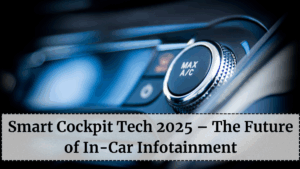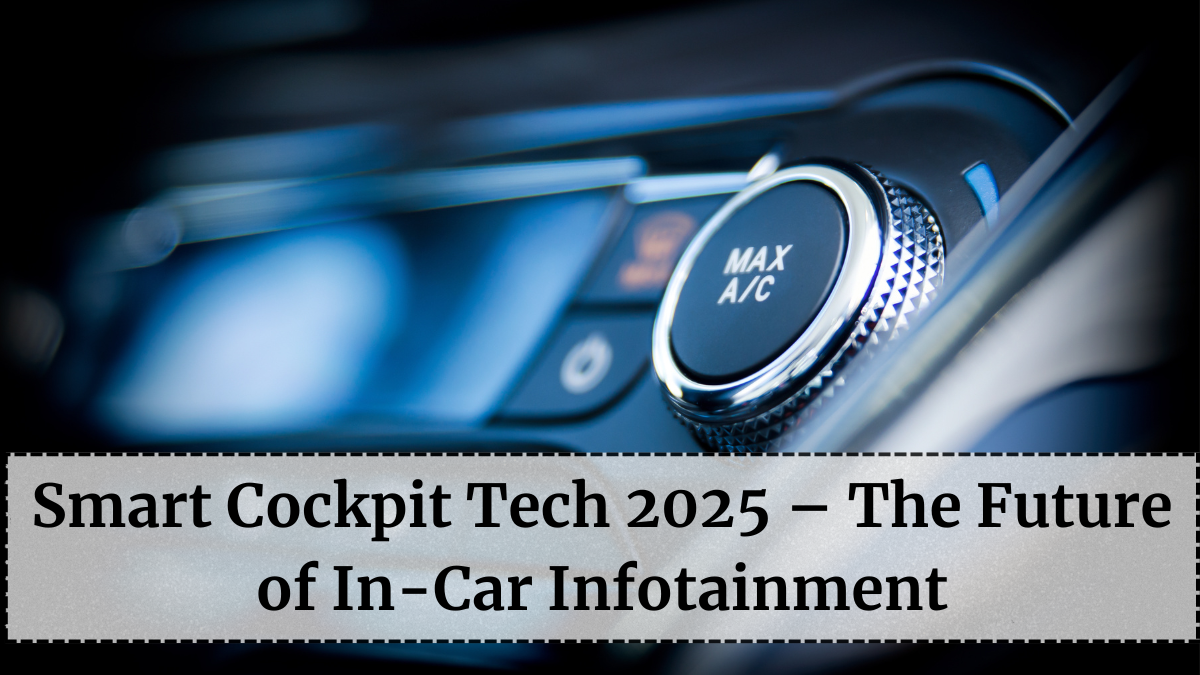Cars are no longer just about horsepower — they’re becoming intelligent digital spaces that adapt to you. With Smart Cockpit Tech 2025, the automobile interior is evolving into a personalized, AI-driven control center designed for comfort, entertainment, and productivity. From voice-controlled dashboards to augmented reality displays, automakers are redefining how drivers and passengers interact with technology inside the vehicle.
The modern cockpit is now a fusion of design, artificial intelligence, and connectivity, creating a seamless bridge between humans and machines.

The Rise of Smart Cockpit Technology
What Is a Smart Cockpit?
A smart cockpit refers to an integrated digital ecosystem inside a vehicle that combines infotainment, navigation, safety, and personalization. It replaces traditional buttons and analog meters with touchscreens, voice commands, and gesture controls — offering a futuristic and distraction-free experience.
Why 2025 Is the Breakthrough Year
With the rise of electric and connected vehicles, 2025 is expected to be the year when smart cockpit systems become mainstream. Automakers like Mercedes-Benz, Hyundai, Tata Motors, and Tesla are introducing next-generation infotainment systems that respond to human emotions, understand speech, and sync seamlessly with smartphones and cloud data.
Key Features of Smart Cockpit Tech 2025
AI-Powered Voice Assistants
AI-based voice assistants are becoming the core of in-car communication. Whether it’s adjusting the temperature, playing a playlist, or finding a nearby café, the AI listens, understands, and acts instantly. These systems use natural language processing (NLP) to understand conversational speech — not robotic commands.
Augmented Reality (AR) Dashboards
AR dashboards are replacing traditional instrument clusters. They project navigation routes, alerts, and speed indicators directly onto the windshield, ensuring drivers never take their eyes off the road. This technology enhances safety while creating a cinematic driving experience.
Multi-Screen Displays and Gesture Control
2025 vehicles are moving toward multi-screen ecosystems — one for the driver, one for passengers, and one for rear entertainment. Combined with gesture recognition, users can swipe, zoom, and control infotainment functions without touching physical buttons.
Cloud Connectivity and OTA Updates
Smart cockpits are designed to stay up to date. Through cloud connectivity, automakers can deliver new features, interface upgrades, and security improvements through over-the-air (OTA) updates — just like smartphones. This ensures your car’s software always feels new.
Emotion Recognition and Ambient Intelligence
Some of the latest luxury models come equipped with emotion detection cameras that read facial expressions and body language. If you look tired or stressed, the system can automatically adjust the lighting, play calm music, or even suggest a rest stop — merging safety with emotional well-being.
Automakers Leading the Smart Cockpit Revolution
Mercedes-Benz Hyperscreen
Mercedes has redefined luxury with its MBUX Hyperscreen, a 56-inch curved glass panel covering the entire dashboard. It integrates multiple screens and uses AI to learn driver habits — even predicting actions like route preferences and seat adjustments.
Tesla Full Self-Driving Interface
Tesla continues to push boundaries with its minimalist cockpit design. The 2025 update includes a fully adaptive interface that displays only what the driver needs at that moment, using AI-driven visibility controls for a distraction-free ride.
Hyundai Ioniq Series Smart Cabin
Hyundai’s Ioniq range uses voice biometrics, health monitoring sensors, and a modular infotainment system that evolves with software updates. The brand’s focus on sustainability extends to its cockpit design, using recycled and plant-based materials.
Tata Avinya Concept
Tata’s futuristic Avinya EV concept showcases India’s entry into the smart cockpit era. It uses a panoramic digital display and AI integration that allows complete voice-based control for comfort, entertainment, and driving settings.
Benefits of Smart Cockpit Technology
-
Enhanced Safety: With hands-free voice commands and AR navigation, driver distraction is minimized.
-
Personalized Experience: AI learns user habits and preferences, tailoring every journey.
-
Real-Time Updates: OTA connectivity ensures constant improvements without physical service visits.
-
Improved Comfort and Productivity: Passengers can stream content, manage work, or enjoy personalized entertainment.
The Road Ahead for Smart Cockpits
By 2025, smart cockpits will become the new industry standard, appearing not just in luxury vehicles but also in mid-range and compact cars. As AI and IoT converge, future cockpits will offer seamless integration between your car, phone, and home ecosystem. Soon, vehicles will understand emotions, predict needs, and create immersive, safe driving environments like never before.
FAQs
What is smart cockpit technology in cars?
Smart cockpit technology integrates digital dashboards, voice controls, and AI features to replace traditional controls with connected, intelligent systems.
How does AI improve the driving experience?
AI enables personalization, hands-free operation, predictive navigation, and even emotional recognition for safer and more enjoyable journeys.
Which brands are leading in smart cockpit innovation?
Mercedes-Benz, Tesla, Hyundai, and Tata Motors are at the forefront of developing AI-powered digital cockpit ecosystems.
Are smart cockpits only for luxury cars?
Not anymore. By 2025, many mid-range cars will feature simplified versions of smart cockpit technology, making it accessible to more consumers.
Can smart cockpit systems receive updates?
Yes, most systems in 2025 support Over-the-Air (OTA) updates, allowing manufacturers to enhance software, security, and performance remotely.
Click here to know more.
